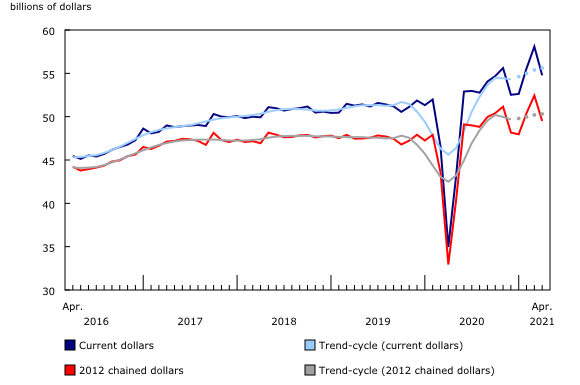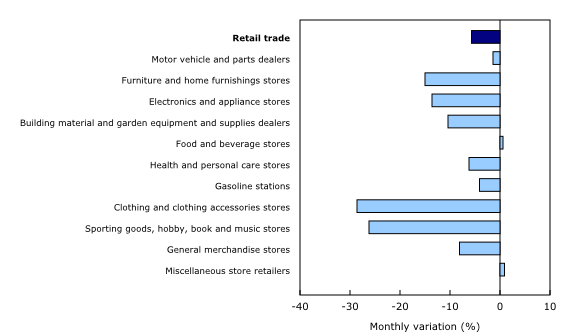Retail trade, April 2021
Archived Content
Information identified as archived is provided for reference, research or recordkeeping purposes. It is not subject to the Government of Canada Web Standards and has not been altered or updated since it was archived. Please "contact us" to request a format other than those available.
Released: 2021-06-23
$54.8 billion
April 2021
-5.7% 
(monthly change)
$871.7 millions
April 2021
1.5% 
(monthly change)
$256.0 millions
April 2021
-0.4% 
(monthly change)
$1,533.7 millions
April 2021
-2.3% 
(monthly change)
$1,281.0 millions
April 2021
1.9% 
(monthly change)
$12,528.5 millions
April 2021
-1.8% 
(monthly change)
$18,805.3 millions
April 2021
-13.4% 
(monthly change)
$1,922.1 millions
April 2021
-8.0% 
(monthly change)
$1,754.8 millions
April 2021
-0.2% 
(monthly change)
$7,427.8 millions
April 2021
0.2% 
(monthly change)
$8,179.4 millions
April 2021
-0.2% 
(monthly change)
$78.4 millions
April 2021
-1.0% 
(monthly change)
$82.8 millions
April 2021
1.2% 
(monthly change)
$45.6 millions
April 2021
0.9% 
(monthly change)
Retail sales were down 5.7% to $54.8 billion in April. The decline coincided with the third wave of the COVID-19 pandemic and was the largest decline in retail sales since April 2020 during the first wave of the pandemic. The largest declines were observed in clothing and clothing accessories stores (-28.6%) and general merchandise stores (-8.1%).
Sales decreased in 9 of 11 subsectors, representing 74.2% of retail trade.
Core retail sales—which exclude gasoline stations and motor vehicle and parts dealers—decreased 7.6%.
In volume terms, retail sales decreased 5.6% in April.
Amid the ongoing COVID-19 pandemic in Canada, provincial governments continued to enact public health measures in several regions across the country, which directly affected the retail sector. In light of continuing restrictions, both retailers and consumers have adapted to these business conditions.
Based on respondent feedback, 5.0% of retailers were closed at some point in April, compared with approximately one-third of retailers being closed at the same time last year. The average length of the shutdown was one day, compared with eight days in April 2020.
Despite these challenging times, most respondents reported their sales figures and Statistics Canada thanks them for their continued collaboration.
Given the rapidly evolving economic situation, Statistics Canada is providing an advance estimate of retail sales, which suggests that sales declined 3.2% in May. Owing to its preliminary nature, this figure will be revised. This unofficial estimate was calculated based on responses received from 62% of companies surveyed. The average final response rate for the survey over the previous 12 months has been 91%.
Widespread declines in core retail sales amid COVID-19 third wave restrictions
Core retail sales fell 7.6% in April, the largest decline in a year and second largest decline on record. The decline was concentrated in those retailers deemed "non-essential," with all store types except food and beverage stores (+0.6%) and miscellaneous store retailers (+0.9%) posting declines.
Sales at clothing and clothing accessories stores fell 28.6% in April. The decline was led by lower sales at clothing stores (-31.3%) and shoe stores (-32.1%). In April, 22.0% of clothing and clothing accessories stores were closed for an average of five days. This represented a widespread re-closing of stores, as 5.1% of clothing and clothing accessories stores reported closures in March.
Sales declined by 8.1% at general merchandise stores. This was the largest decline since the onset of the pandemic in April 2020. Despite the decline in sales, only 0.6% of general merchandise stores were closed during April. Stores may have been impacted in other ways such as restrictions on the types of products they could sell.
Sales at building material and garden equipment and supplies dealers declined for the first time in nine months (-10.4%). Despite the decline, sales remained above levels reached in February 2021. The decline comes after record sales of hardware, tools, and renovation and lawn and garden products in March.
Sales at motor vehicle and parts dealers and gasoline stations fall for the first time in four months
Sales fell by 1.4% at motor vehicle and parts dealers. Sales were down in all four subsectors, led by new car dealers (-1.1%) and automotive parts, accessories and tire stores (-3.5%).
Sales at gasoline stations fell 4.1% in April. Gasoline prices were on the rise in April, in part due to production cuts by OPEC+ countries (countries from the Organization of Petroleum Exporting Countries Plus). In volume terms, sales at gasoline stations declined 3.5%.
Sales down in seven provinces
In Ontario, sales declined 13.4%, the largest decline since the onset of the pandemic in April 2020. Sales declined 8.7% in the census metropolitan area (CMA) of Toronto, whereas sales fell by 16.3% in the rest of the province. The decline in sales was largest at general merchandise stores and clothing and clothing accessories stores.
Quebec (-1.8%) posted the second largest provincial decline. In the CMA of Montréal, sales fell 0.3%, and in the rest of Quebec, sales declined 3.1%.
Sales remained flat in the Atlantic provinces (-0.0%). Second consecutive increases in New Brunswick (+1.9%) and Newfoundland and Labrador (+1.5%) were offset by lower sales in Nova Scotia (-2.3%) and Prince Edward Island (-0.4%).
Retail e-commerce in Canada
On a seasonally adjusted basis, retail e-commerce fell 0.4% in April.
On an unadjusted basis, retail e-commerce sales were up 7.4% year over year to $4.0 billion in April, accounting for 7.0% of total retail trade. The share of e-sales out of total retail sales rose 0.4 percentage points in April.
Note to readers
All data in this release are seasonally adjusted and expressed in current dollars, unless otherwise noted.
Seasonally adjusted data are data that have been modified to eliminate the effect of seasonal and calendar influences to allow for more meaningful comparisons of economic conditions from period to period. For more information on seasonal adjustment, see Seasonally adjusted data – Frequently asked questions.
The percentage change for the advance estimate of retail sales is calculated using seasonally adjusted data and is expressed in current dollars.
This early indicator is a special product being provided in the context of the COVID-19 pandemic to offer Canadians timely information on the retail sector. The data sources and methodology used are exactly the same as those outlined in the Monthly Retail Trade Survey information page.
Trend-cycle estimates are included in selected charts as a complement to the seasonally adjusted series. These data represent a smoothed version of the seasonally adjusted time series and provide information on longer-term movements, including changes in direction underlying the series. For information on trend-cycle data, see Trend-cycle estimates – Frequently asked questions.
Both seasonally adjusted data and trend-cycle estimates are subject to revision as additional observations become available. These revisions could be extensive and could even lead to a reversal of movement, especially for the reference months near the end of the series or during periods of economic disruption.
Seasonally adjusted estimates for cannabis store retailers are presented in unadjusted form since there is no seasonal pattern established by official statistics yet. Establishing such a pattern requires several months of observed data. In the interim, the seasonally adjusted estimates for cannabis store retailers will be identical to the unadjusted figures.
Statistics Canada's retail e-commerce figures include the electronic sales of two distinct types of retailers. The first type does not have a storefront. These businesses are commonly referred to as pure-play Internet retailers and are classified under the North American Industry Classification System (NAICS) code 45411—electronic shopping and mail-order houses. The second type has a storefront and is commonly referred to as a brick-and-mortar retailer. If the online operations of a brick-and-mortar retailer are separately managed, they, too, are classified to NAICS code 45411.
Some common e-commerce transactions, such as travel and accommodation bookings, ticket purchases, and financial transactions, are not included in Canadian retail sales figures.
For more information on retail e-commerce in Canada, see "Retail E-Commerce in Canada."
Total retail sales expressed in volume terms are calculated by deflating current-dollar values using consumer price indexes.
Real-time tables
Real-time tables 20-10-0054-01 and 20-10-0079-01 will be updated soon.
Next release
Data on retail trade for May will be released on July 23.
Contact information
For more information, or to enquire about the concepts, methods or data quality of this release, contact us (toll-free 1-800-263-1136; 514-283-8300; STATCAN.infostats-infostats.STATCAN@canada.ca) or Media Relations (613-951-4636; STATCAN.mediahotline-ligneinfomedias.STATCAN@canada.ca).
- Date modified:



